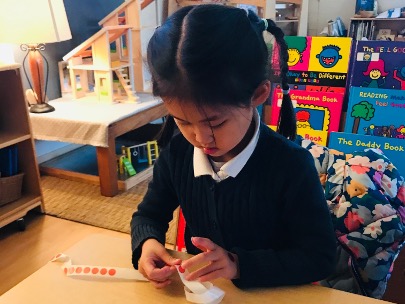“I can give a hint! The next one [number] after something with 9 ends with ‘tee.’ Like twenty-nine, thirTY.’”
Kindergarten mathematicians this week worked together with larger numbers and counting, including making sense of teen numbers, using multiple strategies for counting, and helping name and write numerals. They offered each other helpful tips (like that when you hear 9, think ‘tee’) and played games that include counting by ones, twos, and tens, with jumping or various gestures to mark patterns.
In our “spicy math” station this week, students played card games to identify, match, and combine numbers of dots up to 20. In one game, partners took turns flipping over two cards to reveal their values and tried to make a match (played like “memory”). In another, students looked at all the cards face-up on a table and tried to pull two cards that have 10 dots “all together.” This was tricky! The fun of games with peers—like counting with jumps, finding matches, or going around the room to collect different numbers of objects—all create the motivation to build key skills: counting accurately (which includes both knowing what comes next, but also strategies to not skip or double-count items); combining counts to make new totals; and using counting methods that go beyond one-by-one as we’re ready.
Oh, that’s definitely 9.
As they build fluency, students begin to be able to count on (pick up counting from a different starting place than “1…”), or count by twos to check a total, and to use subitizing (e.g. just “seeing” three dots without counting them) or ten frames and arrays to count more efficiently (e.g. students looked at a now familiar ten frame tool with one dot missing and said “Oh, that’s definitely 9.”) Research shows that students adopt these strategies naturally at their own pace, as they are available around them and as the trade-off of using them makes for less cognitive effort. When they get enough practice to feel super confident, then they readily replace early strategies with more sophisticated ones, moving on their journey from concrete to more visual, and from one-by-one to processing more numbers at once. Joyful and collaborative number games also build a culture of math as a community endeavor where everyone contributes.

